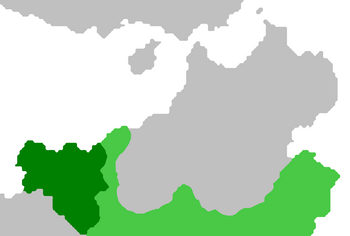Liplisqués Government
Ruttish Republic Ruttųijos Respublika | |||||||||
|---|---|---|---|---|---|---|---|---|---|
| 1928–1934 | |||||||||
 Dark green - Territory under republic's control Light green - Territory occupied by Gaullica | |||||||||
| Status | Puppet state of Gaullica | ||||||||
| Capital | Lipliškės | ||||||||
| Common languages | Ruttish | ||||||||
| Government | One-party military dictatorship | ||||||||
| President | |||||||||
• 1929-1932 | Zydrunas Biržiška | ||||||||
• 1932-1934 | Rytis Sleževičius | ||||||||
| Legislature | Seimas | ||||||||
| History | |||||||||
• Establishment | 18th June 1928 | ||||||||
• Fall of Lipliškės | 4th November 1933 | ||||||||
• Formal abolition | 17th November 1934 | ||||||||
| Currency | Franc | ||||||||
| |||||||||
The Ruttish Republic (Ruttish: Ruttųijos Respublika) was a Great War puppet state established in modern day Ruttland and western Cislania in Werania. Based around the city of Lipliškės it was declared by Ruttish nationalists led by Rytis Sleževičius in June 1929 with the support of Gaullica following their invasion of Werania. It is sometimes referred to as the Lipliškės government after the city it was based in.
The state was governed by the Republican Union, initially a moderate nationalist party but which soon became dominated by functionalists. The new regime targeted ethnic Weranics, Amendists and other opponents of the regime in what was considered large scale massacres. This alienated the Volkhöfen Government, a puppet government in the rest of occupied Werania dominated by August Vorbeck and his own collaborationist National Völkisch Movement. Due to historical cordial ties with Ruttland and Gaullica the republic was afforded special privileges and operated as a largely independent state whilst the Volkhöfen regime de facto only existed on paper and was under military occupation.
The state was reliant on Gaullica, with plans being drafted to announce a monarchy and invite a Gaullican prince to a newly created throne. This did not occur after the fall of Lipliškės to Swetanian-Weranic forces after a short siege. The republic remained in de jure existence until it was abolished by decree in 1934 after which its final president, Zydrunas Biržiška, committed suicide.
The Ruttish Republic was only recognised by Gaullica, other members of the Entente (such as Amathia, Marirana and Xiaodong) as well as a handful of neutral nations. However following the war's end it was declared by the Weranic government that the republic was not a legitimate state and was rather "an appendage to Gaullican military occupation". The legacy of the Ruttish Republic continues to be subject to controversy in Ruttland, especially its relationship to Ruttish nationalism.

